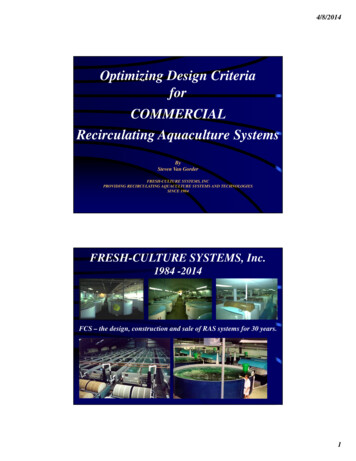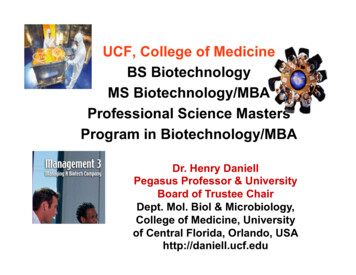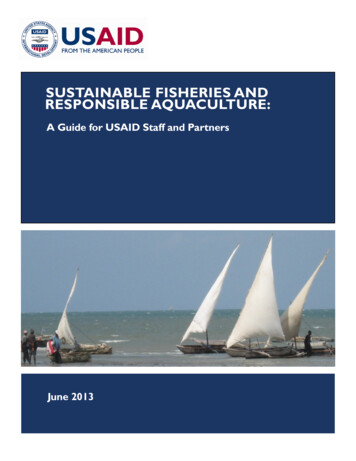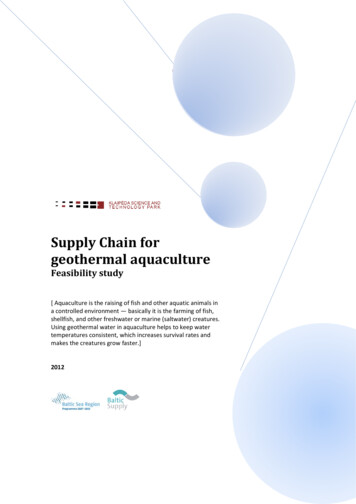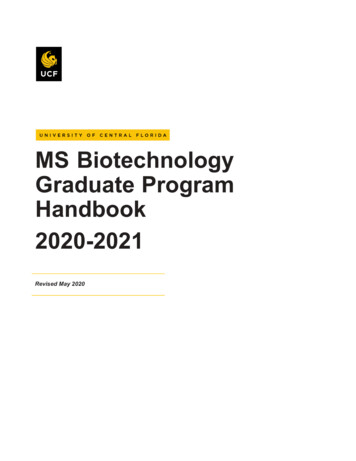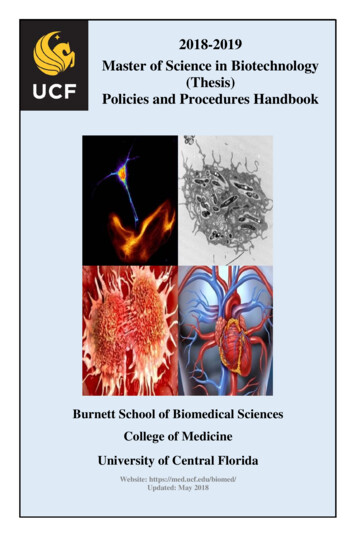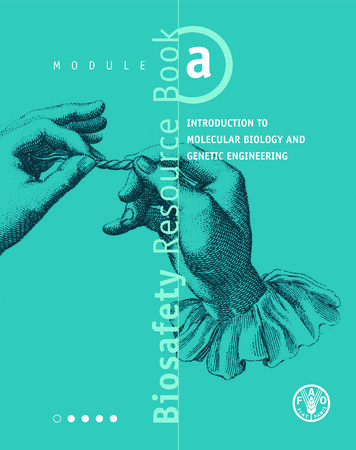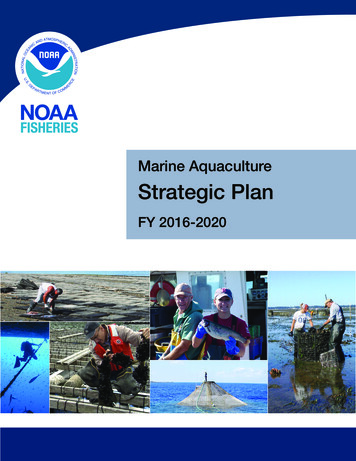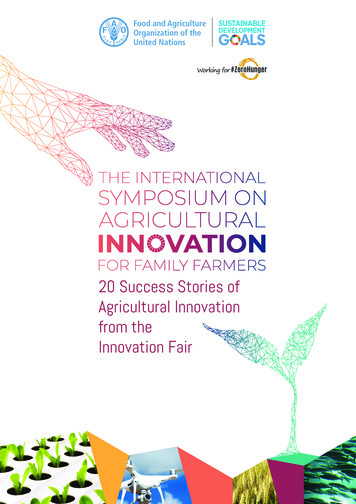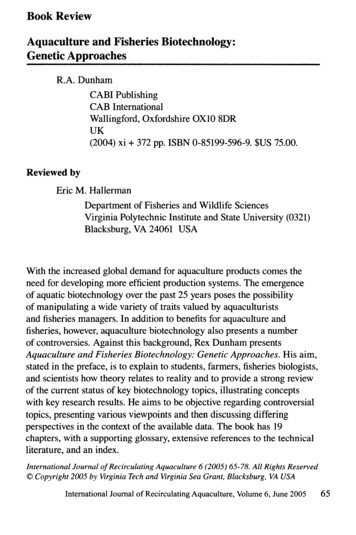
Transcription
Book ReviewAquaculture and Fisheries Biotechnology:Genetic ApproachesR.A. DunhamCABI PublishingCAB InternationalWallingford, Oxfordshire OXIO 8DRUK(2004) xi 372 pp. ISBN 0-85199-596-9. US 75.00.Reviewed byEric M. HallermanDepartment of Fisheries and Wildlife SciencesVirginia Polytechnic Institute and State University (0321)Blacksburg, VA 24061 USAWith the increased global demand for aquaculture products comes theneed for developing more efficient production systems. The emergenceof aquatic biotechnology over the past 25 years poses the possibilityof manipulating a wide variety of traits valued by aquaculturistsand fisheries managers. In addition to benefits for aquaculture andfisheries, however, aquaculture biotechnology also presents a numberof controversies. Against this background, Rex Dunham presentsAquaculture and Fisheries Biotechnology: Genetic Approaches. His aim,stated in the preface, is to explain to students, farmers, fisheries biologists,and scientists how theory relates to reality and to provide a strong reviewof the current status of key biotechnology topics, illustrating conceptswith key research results. He aims to be objective regarding controversialtopics, presenting various viewpoints and then discussing differingperspectives in the context of the available data. The book has 19chapters, with a supporting glossary, extensive references to the technicalliterature, and an index.International Journal ofRecirculating Aquaculture 6 (2005) 65-78. All Rights Reserved Copyright 2005 by Virginia Tech and Virginia Sea Grant, Blacksburg, VA USAInternational Journal of Recirculating Aquaculture, Volume 6, June 200565
Book Review - Aquaculture and nsheries Biotechnology: Genetic ARvroachesChapter 1 presents a short, concise history of genetics and biotechnology,placing aquaculture biotechnology within its larger context. Geneticsis traced from Robert Hooke (cell theory) through Charles Darwin(natural selection), R.A. Fisher and Sewall Wright (quantitative andpopulation genetics), and the rise of molecular genetics and biotechnology.Developments in the breeding of aquatic organisms are traced from nonscientific carp breeding by the Romans and Chinese to the emergence ofscience-based selective breeding, to the rise of aquaculture biotechnology,including ploidy manipulation, sex reversal, gene transfer, and genomics.The chapter effectively provides the historic context for aquaticbiotechnology, and the few glitches (e.g., Frank Ruddie's group producedthe first transgenic mouse - see Gordon et al. 1980, Dolly the sheep wascloned in 1996) will not distract most readers.To effectively measure and exploit the genetic components of variationfor purposes of selective breeding, environmental sources of phenotypicvariation must be recognized and then controlled for experimentally orcorrected. Chapter 2 proceeds from a brief explanation of partitioningof phenotypic variance to a discussion of the numerous types ofenvironmental effects, including stocking density, age, and maternaleffects. Making the point that many published papers in moleculargenetics and biotechnology ignore details of how the fish were cultured,Dunham provides important background for evaluating the validity andcontribution of aquaculture biotechnology studies.Manipulation of entire chromosome sets has proven a key area of aquaticbiotechnology, producing triploid stocks that are sterile or rapidly growingfor particular species. In Chapter 3, Dunham reviews the literature onpolyploidy induction in fish and shellfish, considering methods for ploidymanipulation, ploidy assessment, and performance of triploid stocks. Hethen considers the implications of using existing triploids stocks for arange of potential applications in aquaculture and fishery management.This is generally a strong chapter; Dunham explains why triploidy isor is not a viable option for various species in aquaculture or fisheriesmanagement contexts, and concludes that polyploidy has good potentialfor genetic conservation.Chapter 4 begins by considering gynogenesis and androgenesis,respectively, chromosome set manipulation-based methods for propagatingindividuals with all-maternal or all-paternal inheritance. Methods forinduction of gynogens and androgens are explained, and their use for66International Journal of Recirculating Aquaculture, Volume 6, June 2005
Book Review - A4uaculture and Fisheries Biotechnology: Genetic AQproachesproducing monosex stocks and clonal lines is considered from theviewpoints of phenotypic variability, regeneration of genetic variation,growth, disease resistance, and production of clonal hybrids. I would havevalued a presentation of the author's evaluation of the utility or limitedutility of gynogens and androgens in aquaculture and fisheries. Materialon chromosome set manipulations is followed by material on nucleartransplantation, because both sets of methods relate to cloning. Dunhambegins by explaining the cloning of individuals by transplantation of nucleifrom donor cells to enucleated eggs, citing key studies outside of aquaticsand then focusing on fishes. While the piscine literature is covered ratherfully, some key issues are overlooked. The different implications oftransplanting nuclei from embryonic cells or from fully differentiated cellson subsequent gene expression and performance of the cloned individual(see, for example, NRC 2002) are not discussed. A section on possibleapplications of nuclear transplantation, e.g., for rapid generation of truebreeding transgenic lines would have added to the practical utility of thechapter.Utilization of monosex or sterile populations of fish is a solution orpartial solution to problems associated with sex-related differences inperformance, early sexual maturation, and unwanted reproduction.Techniques available for producing monosex or sterile populations- including chemical and mechanical sterilization and hormonal sexreversal - are discussed in Chapter 5. There is a strong section on geneticsof sex determination in Nile tilapia, and a strong concluding sectionshedding light on practical issues constraining commercialization ofmonosex aquaculture stocks.Development and screening of genetic markers has had a huge impacton aquaculture and fisheries management, an impact that will grow inthe future. Chapter 6 discusses the development of biochemical andgenetic markers and selected applications, mostly on management ofaquaculture species. Methods are discussed in their historical order ofdevelopment, and include isozymes, DNA restriction fragment lengthpolymorphisms, mitochondrial DNA, randomly amplified polymorphicDNA, amplified fragment length polymorphism, microsatellite DNA,expressed sequence tags, and single nucleotide polymorhisms. The relativecosts and effectiveness of the respective marker methods are compared.While the chapter covers methodological and aquaculture-related topicswell, the huge impact of genetic marker methods on fishery managementInternational Journal of Recirculating Aquaculture, Volume 6, June 200567
Book Review - Aquaculture and Fisheries Biotechnology· Genetic Aqproachesis not well addressed. Landmark publications are not mentioned in thecontext of discussions of the respective marker methods, e.g., Ryman andUtter (1987) in the context of isozymes, and the work of John Avise andmany other researchers regarding mitochondrial DNA. MicrosatelliteDNA markers are now the most widely used markers for populationgenetics and have had a huge impact on fisheries management, whichis not discussed or referenced. The last section of the chapter begins toaddress issues posed by management of natural populations, but doesnot draw on numerous case studies that could illustrate applications ofmolecular markers in fisheries management, for example, in managementof anadromous salmonids.Interactions of hatchery and wild fish - a focus of continuing controversyamong aquaculturists, fishery managers, ecologists, and populationgeneticists - are discussed in Chapter 7. The first part of the chapter isintended to provide a foundation for understanding population genetics.The reader would be served by mention and definition of all populationgenetic processes, but the section is very uneven, covering some processesin detail, while covering others only in cursory fashion. For example,discussion of coadaptation and outbreeding depression does not addressthe multilocus nature of coadaptation, as modeled in Sewall Wright's(1932) adaptive landscape. There is a growing literature on coadaptationin fishes (Hallerman 2003) to which interested readers should refer.Mention of many landmark studies or reviews of population genetics offish is omitted, e.g., regarding inbreeding, Allendorf and Leary (1986) onfluctuating asymmetry, or Kincaid (1976a, 1976b, 1983) on inbreedingdepression. Reviews of the huge literature on how population geneticsaffects fisheries management (e.g., Ryman and Utter 1987, Utter andRyman, 1993) might have been cited to give depth to what is necessarilylimited coverage in a single chapter. The issue of how populationgenetics affects conservation was not given sufficient coverage; criticalconcepts such as evolutionarily significant units (ESUs - Waples 1991,Moritz 1994, Nielsen 1995) should have been defined in depth, if onlyto refer the reader to the technical literature. Instead, the issue of whatunit to conserve (page 109) was approached from the viewpoint of"performance" as opposed to adaptive characters. Mention that negativeimpacts of cultured fish upon wild gene pools might be ameliorated bynatural selection was not appropriately qualified by discussion of the longtime required, of the impact of intermittent introductions, and of loss of68International Journal of Recirculating Aquaculture, Volume 6, June 2005
Book Review -Aquaculture and Fi heries Biotechnologv ·Genetic Approachesbetween-population genetic diversity. These are perhaps the best examplesof how, while thought-provoking and citing many interesting studies,the chapter is uneven and written from an aquaculture geneticist's view.Discussion of geographic distribution of genetic variation did not mentionsuch key driving factors as the recolonization of North America by fishesafter deglaciation. Discussion of the effects of stocking hatchery brooktrout did not mention the landmark work of McCracken's group (e.g.,McCracken et al. 1993), and of interspecific hybridization did not mentionintrogression of rainbow trout into cutthroat trout gene pools (Learyet al. 1995). The concluding discussion of an integrated managementstrategy, describing designation of areas where different degrees ofpreservation or manipulation of aquatic gene pools would be practiced,omitted discussion of such key operational issues as how areas would bedesignated and subtleties of management.Development of large numbers of genetic markers gave rise to geneticmapping of entire genomes, detection of loci affecting expression ofquantitative traits (QTLs), and application of such knowledge for geneticmarker-assisted selection (MAS) (Chapter 8). This is a very thoroughchapter in terms of reviewing research to date with aquatic organisms.However, the chapter has its quirks and minimizes treatment of certainkey issues. For example, in a very thorough section on isozyme-basedgenetic maps is a long passage on DNA marker-based mapping of pufferfish. The section on QTL mapping does not mention that segregationis followed within families. The section on MAS might have discussedhow marker and phenotypic performance information are combined ina selection index. There is a huge literature on these topics, and theseshould have been major sections with appropriate citations to the technicalliterature. Certain omissions will make the chapter more difficult formost readers to understand. For example, there is no figure showing agenetic map, nor a figure comparing genetic maps to show conservation oflinkage groups.Elucidation of gene function is a rapidly-developing area of genomics,and Chapter 9 discusses gene expression, isolation, and cloning. Theseprocedures are discussed in the context of what we have learned of suchkey processes as development and growth, reproduction, disease resistance,brain function, cold tolerance, and osmoregulation. Genome-level issuessuch as genetic imprinting, transposable elements, and ribosome functionare described, and the chapter ends with a very brief presentation onInternational Journal of Recirculating Aquaculture, Volume 6, June 200569
Book Review - Aquaculture and Fisheries Biotechnology· Genetic Aooroacbesproteomics. This is generally a well-done chapter, but has its quirks andomissions. Microarrays are not described or shown, leaving the readerwith only a description of their applications. A DNA dot-blot is shown, butneither the genes spotted on it, nor the probe used to screen it are specified.Much more progress has been achieved on understanding of MHC (majorhistocompatibility complex) function and on proteomics than is alludedto. The notion that differential performance of reciprocal crosses of manyspecies may be attributable to genetic imprinting was not considered.Applied with highly visible success in fishes, gene transfer technology isdiscussed in Chapter 10. Given the author's notable involvement in genetransfer in common carp and channel catfish, it is not surprising thatthis is one of the stronger, more thorough chapters in the book. Dunhamcovers gene transfer techniques, expression vectors, integration andtransmission of gene constructs, and pleiotropic effects of transgenes.He considers the performance of transgenic fishes for traits relating togrowth, cold tolerance, and disease resistance. In a more prospectiveanalysis, he discusses transgenic production of pharmaceuticals, geneknock-out technology, and potential role of mitochondrial DNA ingene transfer. The chapter is well illustrated. However, there are a fewquestionable assertions and glitches. The suggestion that use of activetransposons for gene transfer is a good idea should be questioned (NRC2002). Neither the Anderson et al. nor Liang et al. citations seemrelated to cold tolerance. Hybrid breakdown in F 2 and Fx generations iswidely regarded as caused by disruption of coadapted gene complexes(Hallerman 2003), not by nuclear-mitochondrial DNA interactions.Maximum genetic progress in development of genetic lines of aquaticorganisms will come from combining different sorts of geneticenhancement programs. A brief Chapter 11 considers combinations of, forexample, sex reversal and triploidy and gene transfer and crossbreeding.The author is correct in his assertion that combinations of approachesmay be especially powerful when combined, and cites many interestingexamples. However, some biotechnological approaches were not combinedfor the purposes suggested by their inclusion in this chapter. Notably,Devlin et al. (2001) did not crossbreed a transgenic line with a wildpopulation in order to increase the effect of transgene expression, butrather to assess the risks posed by introgression of a transgene into a wildstock. In the context of a passage on gynogenesis and selection to improveimmune response, it is never asked whether a high antibody response70International Journal of Recirculating Aquaculture, Volume 6, June 2005
Book Review - Aquaculture and Fisheries Biotechnology· Genetic Aaproachesis necessarily a desirable trait. These aspects of the chapter can leavereaders unfamiliar with the material without a critical perspective.Aquaculture stocks genetically improved in a research environment arenot necessarily high-performance stocks in a commercial productionenvironment, and such genotype-environment (GE) interactions areconsidered in a brief Chapter 12. The material is straightforward, leadingto the appropriate conclusion that GE interactions on performance shouldbe evaluated before manipulated stocks are commercialized. More detailon how to set up, analyze, or evaluate studies of GE interaction wouldhave been helpful to many readersCommercialization of transgenic aquatic organisms on a large scale posesenvironmental hazards (Chapter 13). Consideration of these hazards fromthe theoretical and empirical viewpoints comprises a large literature.Dunham draws from the literature but sometimes adds inferences thatought to be questioned, resulting in a mix of well-reasoned and lesswell-reasoned arguments. The reader must consider these critically forhim/herself. For example, empirical estimations of fitness componentsgenerally show that fitness-related characters are decreased in transgenics.Recent work on the net fitness of transgenics indicates, however, thatit is not enough to identify a priori a key fitness-determining factor(e.g., vulnerability to predators), show lessened fitness for this trait, andthen conclude that selection will remove the transgene from a receivingpopulation. The net effect of the transgene on overall fitness willdetermine the genetic impacts of transgenics on a receiving population,impacts that may take many generations to reach equilibrium. To arguethat selection would remove maladaptive genotypes from a population,posing only temporary harm (pp. 203, 205) does not consider either the(generally slow) rate at which selection operates in natural populations orthe effect of recurring introductions of such genotypes into a receivingpopulation. The assertions that transgenic fish may not have greatergenetic impact on natural populations than domestic conspecifics (p. 204)or that "all available data indicate that transgenic fish are less fit thannon-transgenics fish and would probably have little, if any, environmentalimpact" (p. 206) are bold speculations. Dunham goes on to suggestthat escaped transgenic fish, by adding genetic diversity to populations,could increase fitness and render such populations more viable, anassertion made by no one else in the sector. This part of the chapterdoes not come to the key bottom-line conclusion, that risk assessmentInternational Journal of Recirculating Aquaculture, Volume 6, June 200571
Book Review - Aquaculture and Fisheries Biotechnology· Genetic Ap,proachesand risk management must be done on a case-by-case basis, consideringspecies, transgene construct, integration event, and receiving ecosystem.Conspicuously missing from the chapter was discussion of studies ofnon-transgenic fish injected with the growth hormone (GH) protein, aready model for GH transgenic fish which can be stocked in the wild forrealistic ecological risk assessment. For example, brown trout injectedwith GH were more willing to risk exposure to a predator than noninjected fish (Johnsson et al. 1996). Similarly, among non-transgenicrainbow trout, aggression was lowest in the control pairs, intermediatein the control/GH-injected pairs, and highest in the GH-injected pairs(Jonsson et al. (1998a), supporting the hypothesis that GH increasesaggression levels. Reproductive confinement would go a long way towardaddressing genetic and ecological hazard posed by transgenic fish andDunham presents a detailed consideration of progress towards achievingtransgenesis-mediated sterility. This is generally a strong passage,although hazard posed by progressive reversion of triploid oysters towardsdiploidy is not mentioned.Foremost in the minds of many consumers is the issue of safety of foodproducts from transgenic organisms. The safety of GM foods has beenexamined thoroughly and is reviewed in Chapters 14 and 15. Chapter 14provides a brief general review and correctly identifies allergenicity asposing the greatest potential for harm to consumers. U.S. oversight by theFood and Drug Administration and international guidelines promulgatedby the Codex Alimentarius Commission are briefly described. Interestedreaders might note that subsequent to the book going to press, FAQ andWHO (2004) published the recommendations to Codex Alimentarius ofa workshop on food safety of products of animal biotechnology includingfish. Issues posed by labeling of GM foods are briefly discussed. Againstthis background, Chapter 15 presents a very detailed case study on safetyof consumption of transgenic salmon expressing elevated levels of growthhormone and insulin-like growth factor. Dunham leads the reader throughthe technical literature to show lack of bioavailability to the humanconsumer and lack of bioactivity of these piscine hormones in humans.Appropriately, he briefly reviews results of Cuban studies of food safety ofgrowth hormone transgenic tilapia. In the best review of the subject that Ihave read, he concludes that GH and IGF levels in transgenic fish productspose no hazards to human health.72International Journal of Recirculating Aquaculture, Volume 6, June 2005
Book Review - A4uaculture and Fisheries Biotechnology· Genetic ApproachesPolicies adopted by nations and international bodies will have majorbearing on the pace and extent of adoption of aquatic biotechnology.Chapter 16 considers regulation of transgenic fish, reviewing developmentof biotechnology policy in the United States, the European Union,Canada, and the United Kingdom. Developments in Cuba and China,countries with transgenic lines in advanced stages of development, arenot discussed. Development of biotechnology policy under the U.N.Convention on Environment and Development is discussed in terms of itsimpact on adoption of GM organisms in developing countries. The effectsof World Trade Organization decisions and intellectual property rights(IPR) will have a large impact on international trade in GM products.While generally a sound treatment, there is no consideration of how IPRcame to be applied to living materials and to animals in particular, asurprising omission given that the landmark case, Ex parte Allen, involvedtriploid oysters and that a key review (Hallerman and Kapuscinski 1990)appears in the list of references. For interested readers, a detailed reviewof 10 states' regulatory policies on GM aquatic organisms is presented byStenquist (1998).Certain products of biotechnology are reaching commercial application(Chapter 17). Triploid salmon, rainbow trout, grass carp, and Pacificoysters are now produced, variously for reasons of reproductiveconfinement and maintenance of product quality after age of maturation.Sex reversal is used to produce all-female salmonid and silver barb andall-male Nile tilapia stocks. Dunham also mentions progress towardspossible commercialization of transgenic fishes, notably the AquaBountyAtlantic salmon (which was not approved by FDA in 2004 as the authorhad expected). Subsequent to the book going to press, GloFish fluorescentzebrafish were commercialized as ornamentals (Hallerman 2004).Chapter 18 - discussing strategies for genetic conservation, genebanking, and maintaining genetic quality - in many respects picks upwhere Chapter 7 leaves off. The first section, discussing populationsize, inbreeding, and maintenance of genetic quality - while a reviewof interesting studies - does not convey a straightforward picture ofprinciples and procedures that a breeder should apply when establishingand maintaining a captive population. For straightforward guidelines,interested readers might consult Tave (1993) for aquaculture broodstocksor Frankham et al. (2002) for stocks of imperiled species. Discussion ofhow to avoid inbreeding notably lacked mention of rotational line crossingInternational Journal of Recirculating Aquaculture, Volume 6, June 200573
Book Review - Aquaculture and Fisheries Biotechnology: Genetic Approaches(Kincaid 1977). A particular level of inbreeding where inbreedingdepression becomes likely was put forward without qualification; thereader would have been better served by mentioning that the criticallevel varies among species, stocks, and environments and supportingthe statement with reference to case studies. The possibility of purgingdeleterious alleles from small captive populations omits mention of theclassical work with Speke's gazelle (Templeton and Read 1984), andof studies questioning the approach (e.g., Hedrick 1994). Discussionof genetic drift does not acknowledge the relevant case where atransgenic line is established by one founder with one integration event.Pathbreaking isozyme-based studies of sperm competition in mixedmilt of salmonids by Gharrett and Shirley (1985) and Withler (1988)are not cited. The chapter ends with a section on genetic conservationemphasizing biotechnological approaches such as cryopreservation andcloning. Considerations regarding living gene banks are not discussed.The flagship genetic conservation program - the Norwegian living andcryopreserved gene banks for Atlantic salmon (Gausen 1993)- is notmentioned. For a complete assessment of the range of issues, interestedreaders might consult Cloud and Thorgaard (1993).Various environmental, research infrastructure, economic, and politicalissues will have to be resolved for aquaculture genetics to make itsmaximum contribution. Chapter 19 presents recommendations forresolution of these issues made by a working group chaired by Dunhamin anticipation of the 2001 International Conference on Aquaculture inthe Third Millennium. These recommendations provide a succinct andappropriate way to put the development of aquatic biotechnology intoperspective at the end of the book.While providing a useful resource, the glossary and references sectionshave some omissions. Key undefined terms pertaining, for example, togenome mapping, include ortholog, paralog, Kosambi cM, paint probe,and centirays. The references section lacks the supporting citation forcertain key studies cited.While I have my criticisms, Aquaculture and Fisheries Biotechnology:Genetic Approaches is the best review to date and will prove useful toa variety of readers. The general strength of this book is the thoroughreview of applications of aquatic biotechnology to aquaculture, and itwill serve as a useful reference to a range of professionals. Its generalweakness regards applications to population genetics and fishery74International Journal of Recirculating Aquaculture, Volume 6, June 2005
Book Review - Aquaculture and Fisheries Biotechnology· Genetic Avproachesmanagement. For teachers, combining a book focusing on selectivebreeding with this volume focusing on biotechnology would support astate-of-knowledge course on genetics in aquaculture.REFERENCESAllendorf, F.W., and Leary, R.F. 1986. Heterozygosity and Fitnessin Natural Populations of Animals. Pages 57-76 in M.E. Soule,ed. Conservation Biology: The Science of Scarcity and Diversity.Sinauer Associates, Sunderland, MA, USA.Cloud, J.G., and Thorgaard, G.H. (Eds.). 1993. Genetic Conservation ofSalmonid Fishes. Plenum Press, New York, NY, USA.Devlin, R.H., Biagi, C.A., Yesaki, T.Y., Smailus, D.E., and Byatt, J.C.A Growth-hormone Transgene Boosts the Size of Wild but notDomesticated Trout. Nature, 2001, 409:781-782.PAO-WHO (Food and Agriculture Organization of the United Nationsand World Health Organization). 2004. Safety Assessment of FoodsDerived from Genetically Modified Animals, Including Fish. PAOFood and Nutrition Paper 79. PAO, Rome, Italy.Frankham, R., Ballou, J.D., and Briscoe, D.A. 2002. Introduction toConservation Genetics. Cambridge University Press, Cambridge, UK.Gausen, D. 1993. The Norwegian Gene Bank Programme for AtlanticSalmon (Salmo salar). Pages 181-188 in J.G. Cloud and G.H.Thorgaard (Eds.) Genetic Conservation ofSalmonid Fishes. PlenumPress, New York, NY, USA.Gharrett, A.J., and S.M. Shirley. A Genetic Examination of SpawningMethodology in a Salmon Hatchery. Aquaculture 47:245-256.Gordon, G.W., G.A. Scangos, D.J. Plotkin, J.A. Barbosa, and P.H.Ruddle. 1980. Genetic Transformation of Mouse Embryos byInjection of Purified DNA. Proceedings ofthe National Academy ofSciences USA, 1985, 77:7380-7384.International Journal of Recirculating Aquaculture, Volume 6, June 200575
Book Review - Aquaculture and Fisheries Biotechnology: Genetic ApproachesHallerman, E.M. 2003. Coadaptation and Outbreeding Depression. Pages238-259 in E.M. Hallerman (Ed.). Population Genetics: Principlesand Applications for Fisheries Scientists. American FisheriesSociety, Bethesda, MD, USA.Hallerman, E.M. 2004. GloFish, the First GM Animal Commercialized,Profits Amid Controversy. ISB (Information Systems forBiotechnology) News Report, June 2004. http://www.isb.vt.edu.Hallerman, E.M., and Kapuscinski, A.R. Transgenic Fish and PublicPolicy: Patenting of Transgenic Fish. Fisheries, 1990, 15(1):21-24.Hedrick, P.W. 1994. Purging Inbreeding Depression and the Probabilityof Extinction: Full-sib Mating. Heredity 73:363-372.Johnsson, J.I., E. Petersson, E. Jonsson, B.T. Bjomsson, and T. Jarvi.1996. Domestication and Growth Hormone Alter AntipredatorBehavior and Growth Patterns in Juvenile Brown Trout, Salmo trutta.Canadian Journal ofFisheries and Aquatic Sciences, 53: 1546-1554.Jonsson, E. J.I. Johnsson, and B.T. Bjomsson. 1998a. Growth HormoneIncreases Aggressive Behavior in Juvenile Rainbow Trout.Hormones and Behavior, 33:9-15.Kincaid, H.L. 197 6a. Effects of Inbreeding on Rainbow TroutPopulations. Transactions of the American Fisheries Society,105:273-280.Kincaid, H.L. 1976b. Inbreeding in Rainbow Trout (Salmo giardneri).Journal ofthe Fisheries Research Board of Canada, 33:2420-2426.Kincaid, H.L. 1977. Rotational Line Crossing: An Approach to theReduction of Inbreeding Accumulation in Rainbow Trout Stocks.Progressive Fish-Culturist, 39: 179-181.Kincaid, H.L 1983. Inbreeding in Fish Populations Used in Aquaculture.Aquaculture, 33:215-227.Leary, R.F., F.W. Allendorf, and G.K. Sage. 1995. Hybridization andIntrogression between Introduced and Native Fish. AmericanFisheries Society Symposium, 15:91-101.76International Journal of Recirculating Aquaculture, Volume 6, June 2005
Book Review -Aquaculture and Fisheries Biotechnologv: Genetic Approaches
Book Review - Aquaculture and Fisheries Biotechnology· Genetic Aqproaches . is not well addressed. Landmark publications are not mentioned in the context of discussions of the respective marker methods, e.g., Ryman and Utter (1987) in the context of isozymes, and the work of John Avis

